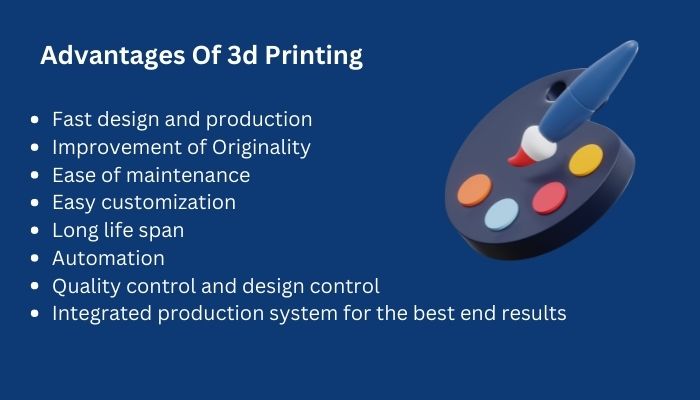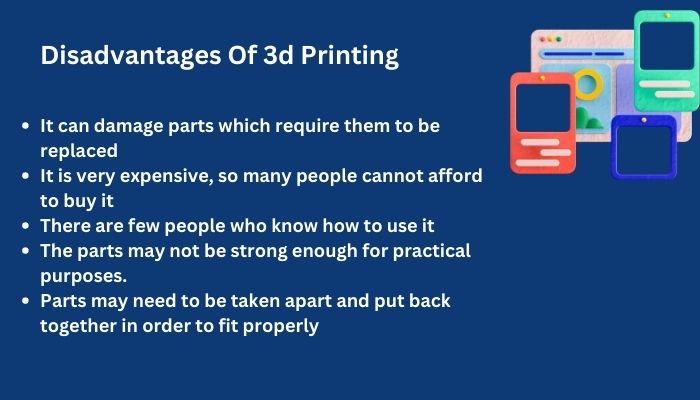3D printing is one of the most amazing technologies to have ever been created. It has completely revolutionized how people can create things, and there are many ways in which it can be used.
Unfortunately, this technology also has a few negative aspects that should be taken into account when adopting it for use. This article will discuss some advantages and disadvantages of 3D printing technology.
What is 3d Printing
3D printing is a rapid prototyping technology that is used to create 3D objects in multiple stages. These 3D objects can be any size, shape, or material. We can conduct this process on any type of material that has been designed in CAD software.
Chuck Hull created the very first fully functional 3D printer in the year 1987 or 1988. Since then, technology has been quickly advancing, and more and more companies have been adopting it for their everyday work.
What Types Of 3d Printing
There are a few different types of 3D printing that can be used depending on the project. These include two-dimensional printing, three-dimensional printing, and additive manufacturing. Two-dimensional printing is used to create or manipulate 2D designs that are within an enclosed space. Below are some kinds of 3d printing.
- Stereolithography (SLA)
- Selective Laser Sintering (SLS)
- Fused Deposition Modeling (FDM)
- Digital Light Process (DLP)
- Multi Jet Fusion (MJF)
- PolyJet.
- Direct Metal Laser Sintering (DMLS)
- Electron Beam Melting (EBM)
Advantages and disadvantages of 3d Printing
2D printing is one of the most simple and easier technologies to use when compared to 3D printing. This is because it requires very little technology that can be made available, and there are no complex machines to use.
But after 3d printing, very few companies are using 2D printing because of the limited opportunities it provides. It can only be used for creating simple objects and cannot be used for complex designs. Let’s explore the benefits of 3d printing.
1. The printing process is fast
Recent research has shown that 3D printing can be done faster than ever before. The printer currently can print parts in as little as 6 to 12 minutes, and the printer does not have to be extremely large and bulky.
2. Flexible Design
3D printing has allowed us to print designs that were previously not possible to create. The designer can create a unique, customized design, and there is no limit on how large they can be, as it is just a matter of placing all the components together.
3. Rapid Prototyping
This is the main benefit of 3d printing. It’s easy to rapidly create a prototype that is flexible, and you can easily change it if needed having no problems.
You can quickly create a new design and use it, and if you dislike it, you can simply produce the required changes. 3D printing is great for mass manufacturing, and it is also a good source of income for over one million businesses worldwide.
4. Reduction of resources
3D printing is a very productive and efficient way to use the materials that you want for your project. This is unlike conventional methods in which we have to buy all the materials from a store or from another employee, and we do this after the fact. With 3D printing, there are no materials wasted.
5. Custom Design Development
2D printing can only create things that are relatively small and shaped, so your choices will always be limited. 3D printing allows you to produce parts and components that are different, as well as designs that are unique. That’s great 3d printing advantage.
6. Reliability
The reliability of 3D printing is very high, as this is an automated process where you do not have to worry about errors. With this technology, it is possible to achieve what you need in a short time with no problems.
7. Quality Control
Once you have created your design, you will determine if it is good for your project or not, and that is why it is important to develop the quality control part of the technology. 3D printing allows you to easily control the quality of your product, and that way it will make no defects.
8. Cost-effectiveness
In the 2D printing process, we have to pay for the materials that we need in order for the process to continue. But with 3d printing, you can easily combine any material that is needed for the project.
9. Marketing opportunities
3D printing has given businesses the chance to develop their own products and launch them to the market using their own design. This is because 3d printing allows you to produce the parts, and then sell them to the public.
10. Upgradability
You can easily upgrade your 3D printer, and this is unlike conventional printers that have to be completely replaced when you want to change them. Below are some other benefits of 3D printing.
Benefits of 3D Printing
- Fast design and production
- Improvement of Originality
- Ease of maintenance
- Easy customization
- Long life span
- Automation
- Quality control and design control
- Integrated production system for the best end results
3d Printer Uses
As we mentioned before, a 3d printer is used for creating different prototypes. We also used them for creating training aids for students. Models may study the engineering mechanism and its parts.
1. 3D printing is being used in many industries
3D printing is being used in the medical industry, aerospace engineering, automobile industry, and many other industries. The aerospace industry is currently using it to create prototype airplanes, and this also allows them to save a lot of money.
2. 3D printers are being used in schools
Students are being educated on how to operate and use the printer, but they also receive a hands-on experience with 3D printing. This will help them be familiar with the technology and what it can do.
3. 3D printing is being used to produce replacement parts
3D printers can produce replacement parts for products of any kind, and this helps people who want to repair their products with the parts they need.
4. 3D printing is being used to create prosthetic, orthotic, and dental devices
3D printing has created the opportunity for many people who cannot afford artificial limbs to create them at home.
5. 3D printing can also be used for medical research
Doctors in countries like the United States and other countries are using 3D printers to create models of the human body to help them understand diseases better. This will allow them to develop drugs much faster, which is very important in today’s society.
6. New patents are being developed every day
The number of patents registered for 3D printing is increasing every year, and the numbers show that about over 200 patents are being created every month.

Disadvantages of 3d Printing
3D printing is not perfect, as it can sometimes produce more errors than we want. We may manufacture some parts with a weak or faulty parts, and this was not the purpose of the printer. Below is a list of the disadvantages of 3d Printing.
1. Copyright Issues
One of the main drawbacks of 3d printing is it has copyright issues. In making parts, the designer needs to be careful of the way they design them, as they cannot be sold or given out to others.
2. Restricted Build Size
People often print prosthetic limbs that are tiny, and therefore several people have difficulty printing them. It is also hard to print something bigger than about 1 meter, but many experts are working hard to improve the issue.
3. Lack of Knowledge and Skills
It’s true that there are not very many people who know how to use 3D printers, but this is slowly changing as teachers are now trained in using the printers. Many schools offer courses for students about using printers.
4. The Cost to Buy
Another disadvantage of 3D printing is the cost to buy. The printers can be extremely expensive, but they are improving the technology every day.
5. It can damage parts
3D printing uses a machine that comes with a high rate of failure, but there are people who are working hard to improve the technology. They are even creating printers that do not need an ink cartridge.
6. High Energy Consumption
The processes that are involved in making the parts require a lot of energy and power. Many people are trying to save on this, but it is going to take time, money, and effort.
7. Long Time Required to Print
The time to make a part using a 3D printer could take hours to even days, and that is why many people are trying to create smaller printers that will produce the parts in a shorter time.

pros and cons of 3d printing
There are many pros and cons to using 3D technology. While it has a lot of advantages, it has some major disadvantages as well.
Pros
- It is easy to use
- Someone can use it anywhere it
- It offers many benefits
- It is now cost-effective and affordable
- There are many people that know how to use it
- People can create their own parts without the help of a designer
Cons
- It can damage parts which require them to be replaced
- It is very expensive, so many people cannot afford to buy it
- There are few people who know how to use it
- The parts may not be strong enough for practical purposes.
- Parts may need to be taken apart and put back together in order to fit properly
FAQs
How is 3d printing beneficial?
3D printing is beneficial because it allows companies and individuals to create parts specially designed for their own needs and uses. In addition, custom-made parts are very common in many industries, such as medicine and the healthcare industry.
Who benefits from 3d printing?
There are many people who benefit from 3d printing. Individuals use it to create products they can use in their businesses or to design products they can sell or give away. Companies also use it regularly to create prototypes and other items that they need for their business.
Why is 3d printing important?
3D printing is very important. Not only does it allow individuals to create parts for themselves, but it also allows them to create new products that they can sell in their business or that they can design for others to use.
Conclusion
3D printing is something that has a bright future. It will continue to improve, and it will help many people create the products that they need or want. It is definitely something that many experts are monitoring.
3D printing is an additive manufacturing process that uses 3D data to create a physical object from a digital file. We hope you enjoyed this article advantages and disadvantages of 3d printing and we would like to know what you think about 3d printing pros and cons.

